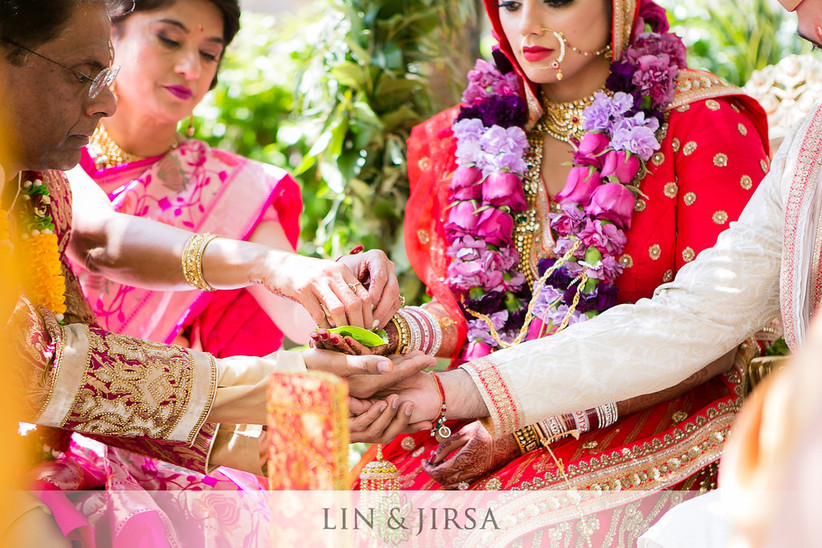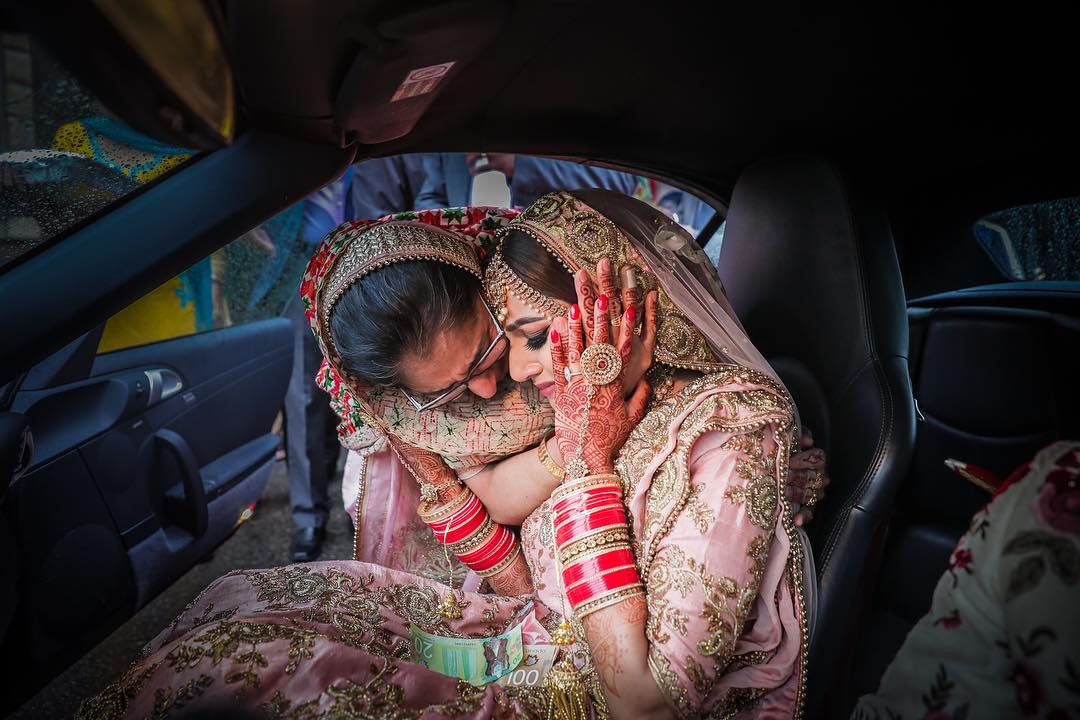MARRIAGE IN UTTRAKHAND

Uttarakhand is predominantly covered by rolling hills and mountains with the Himalayas towards the North and the Garhwali and the Kumaoni ethnic communities which make up for the cultural richness of the region. Since they reside in the mountains and hills, therefore, their attire is also developed out of the climatic conditions and is therefore reasonably warm.
Kumaoni or Garhwali weddings of the ethnic communities in Uttarakhand are very simple, although the various rites and rituals before, during and after the wedding are quite intricate. The traditional bride dons the typical Ghaghra-Pichora. The Pichora is perhaps the only part of the entire bridal attire that looks completely different and is a rich legacy that is passed on throughout generations. The Pichora has utmost importance in a Uttarakhand wedding and is akin to what a khara dupatta means to a Hyderabadi bride.
Besides all these the uttrakhandi brides are also very beautifully adorned .They wear a naath ,maang tika ,guloband[in some parts],etc.There wedding is also very beautifully done in villages as well as in cities or towns.
The Pichora is traditionally hand-made as is dyed with vegetable colors after which it is printed by hand; however, a lot of machine-made duplicate pichoras are invading the market. There are only two colors that are used in the Pichora – red and saffron. They are considered auspicious colors in Indian culture. The red color stands for energy and conjugal life, while the saffron represents all the holy and worldly elements. The combination of these two colors brings in good luck to the bride for her married life ahead.
The traditional Kumaoni or Garhwali bride would wear the traditional ‘Ghagri’ which is the skirt-like garment just like the ghaghra along with a ‘choli’ (the blouse) and the traditional ‘Pichora’ which is also called ‘Rangwali’ and is a traditional ‘odhni’ or veil that is embellished with silver and gold tatting’s. However, apart from donning the ghagri-pichora, the more conventional Uttarakhand bride prefers wearing a saree.On the other hand, the traditional costume of the groom in Uttarakhand is the dhoti-kurta or pyjama-kurta along with the traditional headgear for the weddings in Uttarakhand.
Pre-wedding ceremonies
Engagement:
 To begin with the conjugal ceremonies held in Kumaoni weddings let’s
start from the engagement. Just like other weddings, Kumaoni weddings
also observes an engagement ceremony which is quite unique from others.
As in here, the fathers of the to be wedded couple exchange the rings
instead of the bride and groom.
To begin with the conjugal ceremonies held in Kumaoni weddings let’s
start from the engagement. Just like other weddings, Kumaoni weddings
also observes an engagement ceremony which is quite unique from others.
As in here, the fathers of the to be wedded couple exchange the rings
instead of the bride and groom.
 Mehendi ceremony:
Mehendi ceremony:
Followed by the engagement is the Mehendi ceremony in which the henna
is applied on the hands and feet of the bride. The Mehendi ceremony
takes place on both the sides. While the bride applies a full-fledged
heavy henna design on her hands, arms, and feet. The groom goes for a
simple yet modest henna design that is decorated on his hands. It is
said that the darker the henna colour will turn out to be, the more
loving your husband will be.Ceremonies performed during the wedding
According to the Hindu beliefs, during the marriage, the bride and groom takes the position of Lord Vishnu and Goddess Parvati and are treated likewise.Ganesh Puja:
Ashtavinayak or Lord Ganesha is believed to be the remover of obstacles, therefore, any propitious work starts after offering prayers to the deity and requesting him to remove all the obstacles, hindering the auspicious work. Since a wedding is one of the most beautiful and important stages of life, therefore it is started after paying obeisance to Lord Ganesha.
Suwal Pathai:
 This unique ceremony is a very specific in Kumaoni weddings wherein
the wheat flour is kneaded into dough and rolled in circles (like
flatbread but a little thinner). It is then dried in the sun after
dipping in dry flour. Once they are dried, they are deep fried and are
offered as a Prasada to the gods.
This unique ceremony is a very specific in Kumaoni weddings wherein
the wheat flour is kneaded into dough and rolled in circles (like
flatbread but a little thinner). It is then dried in the sun after
dipping in dry flour. Once they are dried, they are deep fried and are
offered as a Prasada to the gods.Duliagarh:
Since the ‘dulha’ or the groom is treated as Lord Vishnu, therefore, he is worshipped by the bride’s father and the priest. The feet of the groom are washed by the father of the bride and ‘pithya’ or sweets are offered to him. This ceremony lasts for about 30 minutes after the ‘baraat’ or the groom’s procession has reached the wedding venue.
Varmaala:
This ceremony is basically the exchanging of garlands and it takes
place after Duliagarh when the groom makes his advancement towards the
center stage. Once he takes his seat, the bride also joins him shortly.
The family and a few close friends of the bride and groom also accompany
them on the stage, at their special moment. The Jai Mala is then
exchanged by the couple and the crowd cheers the couple with a big round
of applause, accompanied by a few friendly jokes and gigs.
 Photo session and dinner:
Photo session and dinner:
After the couple has exchanged garlands, the camera starts rolling to
take out wonderful pictures of the couple along with their family,
friends, and relatives. The guests congratulate the couple and usher
blessings on them. Followed by the photo session, is the feast which the
guests enjoy simultaneously. By the time the guests have tempted their
palates with delicious food, they throng to the dance stage to set it on
fire. Once the guests are done with dinner and dance, the couple
finally gets the chance to have dinner together. They are accompanied by
their loved ones and family for a special dinner which is a happy
moment for the couple.Holy ceremonies and Kanya Daan:
 When the social formalities are done, the priest takes over and
conducts several holy rituals and ceremonies that are performed as per
the ‘lagna’ (the positioning of the stars according to the horoscope of
the bride and groom). This ceremony takes a few hours and usually lasts
the entire night until morning. Then comes the ‘Kanya Daan’, the
emotional and most important ritual conducted by the bride’s father and
mother. The parents of the bride observe a fast on this day. Kanya Daan
is considered as the biggest donation that anybody can ever make. After
performing the ceremony, the bride becomes a part of the groom’s family
and his better half for life.
When the social formalities are done, the priest takes over and
conducts several holy rituals and ceremonies that are performed as per
the ‘lagna’ (the positioning of the stars according to the horoscope of
the bride and groom). This ceremony takes a few hours and usually lasts
the entire night until morning. Then comes the ‘Kanya Daan’, the
emotional and most important ritual conducted by the bride’s father and
mother. The parents of the bride observe a fast on this day. Kanya Daan
is considered as the biggest donation that anybody can ever make. After
performing the ceremony, the bride becomes a part of the groom’s family
and his better half for life.

Comments
Post a Comment